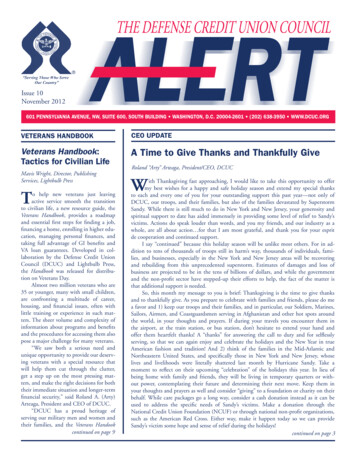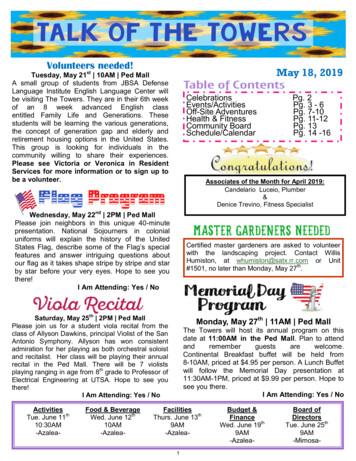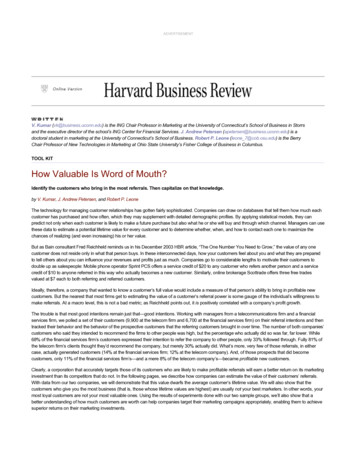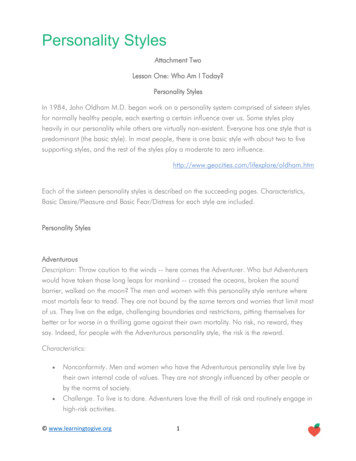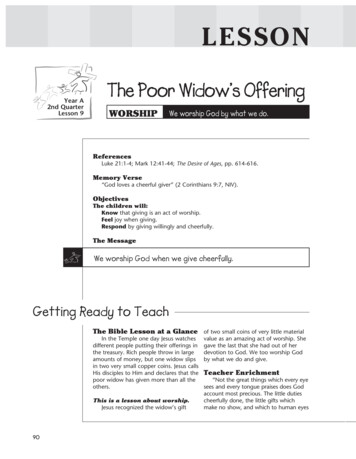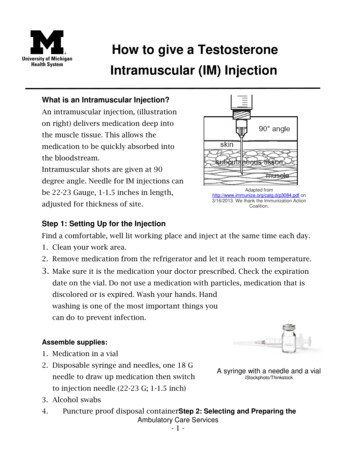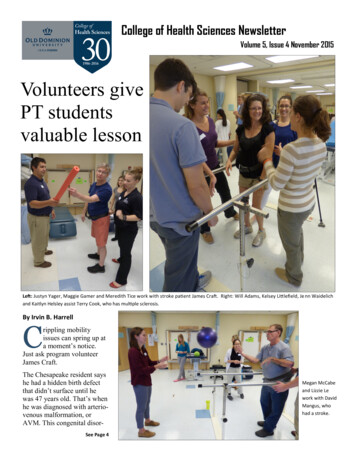
Transcription
College of Health Sciences NewsletterVolume 5, Issue 4 November 2015Volunteers givePT studentsvaluable lessonLeft: Justyn Yager, Maggie Gamer and Meredith Tice work with stroke patient James Craft. Right: Will Adams, Kelsey Littlefield, Je nn Waidelichand Kaitlyn Helsley assist Terry Cook, who has multiple sclerosis.By Irvin B. HarrellCrippling mobilityissues can spring up ata moment’s notice.Just ask program volunteerJames Craft.The Chesapeake resident sayshe had a hidden birth defectthat didn’t surface until hewas 47 years old. That’s whenhe was diagnosed with arteriovenous malformation, orAVM. This congenital disorSee Page 4Megan McCabeand Lizzie Lework with DavidMangus, whohad a stroke.
COLLEGE OF HEALTH SCIENCESPAGE 2Dean’s Message: From the Assistant DeanGiving has several unsung heroesIn the College of Health Sciences there are many individuals and groups who make adifference in the lives of others every day. We are lucky to work with them – they arefun, they are there for others, they have an amazing attitude, and they just simply makeour day! This time of year is called the season of giving, but these folks give generously every day of the year.Dean Shelley Mishoe is one of these individuals. It is a pleasure to watch her in action,laughing, enjoying the moment, making things happen for our College and making adifference for students, faculty, staff, Old Dominion University and our communities.Debbie Bauman,Assistant DeanThe chairs of our schools work so hard. The word “giving” is not included in their jobdescriptions, however, each chair is completely selfless. Dr. Bonnie Van Lunen, Dr. Deanne Shuman, Dr. Susan Daniel, Dr. Karen Karlowicz and Dr. Roy Ogle serve unlimited constituencies, exceed expectations, andinspire innovation. As a result, the College of Health Sciences continues to expand and achieve ambitiousgoals.This is the season of giving. The College of Health Sciences is thankful for the gift of exceptional leadership.Enjoy the end of a wonderful semester. Take time to play, be there for others, and laugh!From the EditorStudent takes initiative, gets writing gigOpportunity came knocking earlier this semester when I wascontacted by a student in the Public Health Program who wanted to know how she could “get involved” in the College ofHealth Sciences’ monthly newsletter.The student, Angelica Walker, told me she was looking for anopportunity to get experience that would position her for a possible internship in the summer. It sounded like the perfectteaching moment for me, so I had her send me some writingsamples.Irvin B. Harrell,Coordinator of Strategy& MarketingMy plan was to enlist her as a writing intern of sorts, providinga student perspective piece to our newsletters. Not only would she be able to writemonthly stories, but I would serve as her mentor/editor. After reading her samples, Iwas convinced that she had the “write stuff,” and this month’s newsletter will featurethe first of several stories she will write in the coming months. You can find her firstinstallment on Page 8 of this issue.
COLLEGE OF HEALTH SCIENCESPAGE 3School of Community and Environmental HealthStudent gets special presentation opportunityRebecca Hopkins, a Master of Science studentin the Community and Environmental Health Program, presented a poster on her practicum projectthis fall for her degree at the regional AmericanSociety for Safety Engineers (ASSE) meeting inMyrtle Beach, S.C.Rebecca presented her poster on Sept. 30. The regional conference, titled “2015 Region VI 29thAnnual American Society of Safety EngineersProfessional Development Conference,” was attended by about 200 professionals. She was one of15 students selected to attend and present theirwork, and was the first student from Old Dominion University to be selected to attend this conference.“I was able to learn new things in regards to thefield, listen to great speakers, and network withmany professionals from different locations,“ Rebecca said.The ASSE was founded in 1911 and is the world’soldest professional safety society. The global association of occupational safety professionals represents more than 36,000 members worldwide. Thesociety is also a visible advocate for OccupationalSafety and Health Administration (OSHA) profes- Rebecca Hopkins presents at the ASSE meeting in September.sionals through proactive government affairs at thefederal and state levels, and in member-led relationships with key federal safety and health agencies.College leads pack in annual giving campaign participationThe College of Health Sciences led the pack this year in participation inthe Old Dominion University Faculty & Staff Campaign 2015.The college’s participation rate of 40 percent was the highest among thecolleges, beating out the Strome College of Business by one percent.The college had 44 donors and raised 34,724, the second-highest total ofany university department and second-highest among the other colleges.Participation rates School of Dental Hygiene: 62%Community and EnvironmentalHealth: 43%Medical Diagnostic and TranslationalSciences: 41%Physical Therapy and Athletic Training: 36%School of Nursing: 33%
COLLEGE OF HEALTH SCIENCESPAGE 4Community volunteers give students valuable lessonFrom Page 1der of blood vessels in thebrain is characterized by atangled web of abnormal arteries and veins.The condition, which occursin less than 1 percent of thegeneral population, can bedevastating and even fatal.AVMs can cause intracranialbleeding; seizures; extremehead pain; stroke; and difficulty with speech, movementand vision. In Craft’s case, hesuffered a stroke in 2005 andhad a severe brain hemorrhage.As a result of AVM, Crafthad brain surgery, and sayshe was told “I’d probablyKayla Trantham examines Debbie Lovell, who had a stroke.never walk again.” Not oneto take that prognosis sitting, Craft has been coming to Old Dominion University since 2009 – and working onhis walking.Every fall, since 2005, ODU’s Doctor of Physical Therapy students have been working with volunteer patientslike Craft as part of a special program that combines community outreach and real-patient experience.The program – started by senior lecturers Dr. Mira Mariano and Dr. Beth Jamali – pairs groups of studentswith local residents who have neurological conditions, such as brain injuries, multiple sclerosis, Parkinson’sdisease, stroke and other conditions that affect mobility, balance and function. The volunteers come to the Program in Physical Therapy’s lab, where they are evaluated by students under the close supervision of the PTfaculty. The students practice their evaluation techniques with the clients and then work with them to deviseinterventions for their mobility problems.“All students participate in four sessions as a part of their coursework,” Mariano said. “We use between 12and 15 volunteers for the first three sessions and then about 25 to 30 clients for the last session, which is thestudents’ final neurological practical exams.”The volunteers, many of whom return annually to the program, are no stranger to working with students andare quick to critique any situations where they believe care could have been better. They also have formedsome lasting bonds amongst themselves while participating in the program.“The students give me a chance to remember the correct ways to repair my stride and gait,” says Craft, a former parts manager for a tractor dealership.Craft says he learned about the program when Mariano and Jamali came to a stroke support group at the Chesapeake Regional Medical Center, where both faculty are employed.See Page 5
COLLEGE OF HEALTH SCIENCESPAGE 5From Page 4The use of neurological communityvolunteers is a break from the Program in Physical Therapy’s traditional use of standardized patients, whoare actors used in educational settingsfor many health care students.“We used to use standardized patients for the practical examinations butit is really difficult for them to portrayconsistent neurological signs andsymptoms reliably,” Mariano said.“We are both still active in clinicalpractice so we thought we would askour former patients if they wanted tocome in and volunteer their timeworking with our students.”And it worked.The two faculty started with a handfulof volunteers and they now have adatabase of “about 45 to 50 clientswho come in for up to four lab sessions each fall.” They also have addedto their volunteer numbers by makingbrochures seeking referrals for localclinics where they have existing relationships.The use of community volunteers hasbeen a multiple-win situation,Student Kim Lyons examines Nelson Molony.Mariano says. It has provided a practical experience for the students, free assistance for those in the community, and an opportunity for both thefaculty and the volunteers to teach.“In a way, the volunteers ‘teach’ our students about some things that cannot be learned through didactic teaching,” Mariano said. “Things like being patient when a person has difficulty speaking after a stroke; being empathetic when someone talks about how they were not able to return to work after their head injury; being acoach to push a patient when they think that they cannot do something, etc ” she said. “These qualities arediscussed but are difficult for students to exhibit on their own classmates in role-play lab practice and are oftennot developed yet in physical therapy students while still in training.”Mariano added that many of the sites in the school’s clinical rotation comment on how her students “hit theground running.”“I really feel like these experiences help to facilitate that,” she said.For Craft, who turned 58 this year, the program has been a godsend. It has provided him with an annual costfree source of rehabilitation.“It has been a beautiful opportunity,” he said.
COLLEGE OF HEALTH SCIENCESPAGE 6Dental HygieneMembers of the Dental Hygiene Class of 1980 pose with Big Blue. From left: Cindy Dill Fries, Anna Liatos Haupt, Debbie BlytheBauman, Cathy Stump Lemberg, Julie Stang Brown, and Tricia Drewry Faubert.School holds special homecoming celebrationODU Homecoming was a great day for all, but especially for dental hygiene students. This was the secondyear the Student Chapter of the American Dental Hygienists’ Association (SADHA) sold corsages as a fundraiser coordinated by two alumni, Rhonda Lucas and Lisa Doyle. It was the first year that a group of theschool’s students marched in the parade carrying a banner for the student association and distributing toothpaste and toothbrushes along the parade route.The Class of 1980 gathered for an alumni event coordinated by Assistant Dean Debbie Bauman, also a graduate of the 1980 class. The event began with a tour of the Dental Care Facility and an update of the programsand initiatives of the school provided by Dr. Susan Daniel, chair of the school. Following the tour, membersof the class attended a pregame tailgate. Two faculty presented research posters at the Canadian Dental Hygienists’ Association annual conference inVictoria, British Columbia. “Avatar-Mediated Practice Scenarios to Evaluate Cross-Cultural Knowledge andUnderstanding” was presented by Tara Newcomb and “Brush Up! Promoting Oral Hygiene Behaviors with AGame” by Joyce Flores.
COLLEGE OF HEALTH SCIENCESPAGE 7Center for Global HealthODU grad uses innovation to help farmers in developing countriesThrough the collaboration of Old Dominion University’s Center for Global Healthand the Strome Entrepreneurial Center, aspecial seminar was presented last monthtitled “Digital Innovations at the Last Mileof Agriculture – Empowerment of Smallholder Farmer.”Dr. Venkat Maroju, who received hisPh.D. in Mechanical Engineering at ODUin 1995, was the special guest speaker atthe seminar on Oct. 16 at the entrepreneurial center on the university’s Norfolk campus.Maroju is the chief executive officer ofSourceTrace Systems in Cambridge, Mass.His company provides customized remotetransactions solutions and real-time operating platforms for agribusiness, financialDr. Muge Akpinar-Elci, director of the ODU Center for Global Health, introduces Dr. Maroju.inclusion and retail solutions. SourceTraces’ expertise is a valuable resource, particularly in areas such as Bangladesh, India and Costa Rica, where smallfarmers lack adequate resources to market their crops.The company’s business solutions allow the farmers in remote areas to track the flow of goods from the source to thecentral processing facilities. They also provide the capability to collect data on mobile devices which can result in informative market analytics. The impact not only allows for entrepreneurship but also positively impacts global health.Maroju, who was born in India, says public education in his country is terrible and that government red tape as well ascases of fraud make things difficult for small farmers there.Before coming to SourceTrace, Maroju spent time working in the auto industry. As the divisional information officer forBose Corp., he led the information systems strategy and implementation for the global Automotive Division with presence in the U.S. Europe, Japan and China. He also founded a holding company in India that set up and promoted agribusiness ventures.Maroju says his work with smallholder farmers has been extremely rewarding.“I’ve always had a passion for social issues,” he said.30th anniversary around the cornerThe College of Health Sciences’ 30th Anniversary is approaching, and plans are under way to celebrate. Whilethe actual anniversary will be July 2016, we will beplanning several stories and events as a curtain-raiser tothis historic occasion.Our newly designed badge, right, will serve as a symbolof our celebration, so expect to see it on many of ourcommunication materials in the coming year.
COLLEGE OF HEALTH SCIENCESPAGE 8Opportunities aboundfor hands-on experienceBy Angelica WalkerWhen it comes to careers in health science, there is no shortage of variety.According to the U.S. Department of Labor, the healthcare industry is expected to grow more than any other sector, yielding 15.6 million jobs by2022. If you’re looking for your dream job, keep in mind that employerswill look for those not only with the proper education, but those who havehands-on experience. While Old Dominion University can provide the education, getting the experience can be a different story.One option to get real-life experience is working with the Norfolk MedicalReserve Corps (MRC). The MRC is a branch of the Norfolk Health DeAngelica Walkerpartment that works with other agencies to safeguard and enhance thehealth of the local community. It offers free training such as cardiopulmonary resuscitation (CPR), Basic LifeSupport (BLS) and shelter trainings to prepare for emergencies. There are numerous volunteer opportunitiesmonthly to assist with first aid, shelter organization, preparedness and more.The MRC also provides opportunities to network with other healthcare professionals. Additionally, it is a repository of information, tips and wisdom in reference to building a career path. Through working with theMRC, you can get the opportunity to practice important tasks that will be necessary in your future career suchas maintaining confidentiality, working well with the public, and using leadership skills to work with othersand make critical decisions. To get more information or to get involved, contact MRC coordinator Linda Bottsat linda.botts@vdh.virginia.gov.Tenisha Charles, a 24-year-old ODU College of Health Sciences graduate, participated in a American RedCross internship at the national headquarters in Washington, D.C., over the summer.“It was one of the most fulfilling learning experiences of my life,” she said.As part of her internship, Tenisha attended meetings and workshops with executives to learn more about theirmission and health initiatives. While networking with Red Cross leaders, she was able to gain professional experience and get a realistic view of what to look forward to in her career.Other opportunities The American Red Cross offers paid and unpaid internships during the fall, spring and summer. The openposting for spring 2016 internships began in early October and the next open posting for summer 2016 internships will begin Dec. 7. To be considered, simply email your resume to internships@redcross.org . All otherspecific internship roles can be found on ss. Erika Dillard, the volunteer resources specialist in Norfolk, handles recruitment in the area. She seeks candidates for jobs such as a transportation specialist – which delivers blood donations to hospitals or back to theblood bank – or a disaster action team member, which assists with disasters like residential fires during latehours and on holidays. Dillard welcomes all inquiries and can be reached at erika.dillard@redcross.org. If you are looking to beef up your knowledge, Training Finder Real-time Affiliate Integrated Network National (TRAIN) is a free service through the Public Health Foundation. TRAIN is a resource for public healthprofessionals that assists in finding training courses and also provides some trainings and continuing educationcredits at no cost. Get involved by visiting https://www.train.org/DesktopShell.aspx. CDC Train, an affiliate ofTRAIN, is an external learning management system for public health professionals as well. Course lists andother information on continuing education can be found on https://cdc.train.org/DesktopShell.aspx.
COLLEGE OF HEALTH SCIENCESPAGE 9Upcoming EventsNovemberNov.25Nov. 26-27University Closes at noon for Thanksgiving HolidayThanksgiving Holiday – University ClosedDecemberDec. 1COHS Holiday Luncheon Celebration, 11:30 a.m.-1:30 p.m.Location: Ted Convocation Center, Multipurpose RoomDec. TBDUpsilon Phi Delta Induction Ceremony (health care managementstudents)Dec. 4Classes EndDec. 5-11Final ExamsDec. 12Fall Commencement , Location: Ted Convocation CenterDec. 24-Jan. 1University Closed for Holiday
Dental Hygiene Members of the Dental Hygiene lass of pose with ig lue. From left: indy Dill Fries, Anna Liatos Haupt, Debbie lythe auman, athy Stump Lemberg, Julie Stang rown, and Tricia Drewry Faubert. School holds special homecoming celebration ODU Homecoming was a great day for all, but
